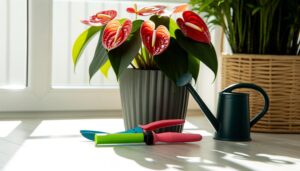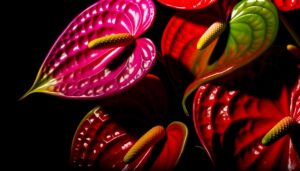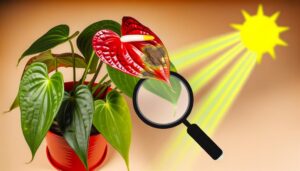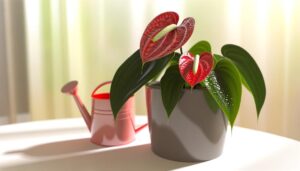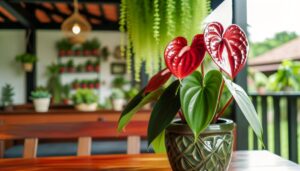Rescuing Your Pink Anthurium From Brown Leaves
Identify and address issues causing brown leaves on your pink anthurium by examining for chlorosis, necrosis, and pigmentation. Check for fungal infections or pests, moisture levels, and root health.
Overwatering can lead to root rot, while underwatering causes desiccation. Maintain humidity levels between 60-80% and provide indirect light to avoid photodamage.
Use a well-draining mix with orchid bark, perlite, and peat moss. Regularly inspect for pests and diseases, and prune damaged leaves with sterilized tools.
Following these guidelines helps restore your plant's vibrancy—understanding these steps further will enhance your anthurium care.
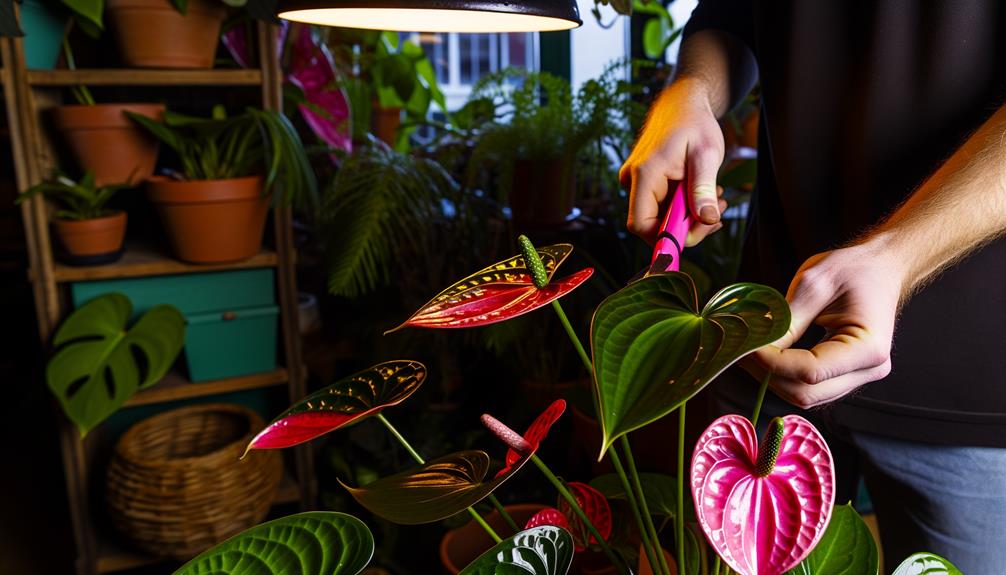
Key Takeaways
- Inspect and adjust watering habits to avoid root rot from overwatering or dehydration from underwatering.
- Maintain humidity levels between 60-80% to prevent leaf dehydration and browning.
- Position your Anthurium in indirect light to avoid photodamage and ensure even light distribution.
- Use a well-draining potting mix with orchid bark, perlite, and peat moss to support healthy root development.
- Regularly inspect for pests and diseases, using insecticidal soap or neem oil for pests and copper-based fungicide for fungal infections.
Identifying the Problem
To effectively diagnose issues with your pink anthurium, start by closely examining the plant for signs of distress such as discolored leaves, wilting, or poor growth. Carefully inspect the foliage for chlorosis, necrosis, or any unusual pigmentation.
Check the petioles and leaf axils for signs of fungal infections or pest infestations. Assess the root system by gently removing the plant from its pot; healthy roots should be white and firm, not brown or mushy.
Observe the soil moisture levels and texture, ensuring it's neither too dry nor overly saturated. Document any anomalies you find, as this data will be essential for determining the underlying issue.
Common Causes of Browning
To address browning in your Pink Anthurium, examine your watering habits, as both overwatering and underwatering can induce cellular stress, leading to necrosis.
Evaluate the ambient humidity, since insufficient moisture in the air disrupts the plant's transpiration process.
Additionally, assess light exposure, as excessive direct sunlight can cause photodamage to the delicate leaves.
Watering Habits
Incorrect watering habits, such as overwatering or underwatering, are primary factors leading to the browning of your pink anthurium's leaves. Overwatering causes root rot due to the anaerobic conditions created in waterlogged soil, preventing oxygen uptake.
Conversely, underwatering results in desiccation, where the plant's tissues lose water faster than it can absorb, leading to cellular dehydration. Use a well-draining potting mix and make certain the top inch of soil dries out before rewatering. Utilize a moisture meter to maintain precision.
Humidity Levels
Maintaining perfect humidity levels is crucial for preventing the browning of your pink anthurium's leaves, as low humidity can lead to increased transpiration and subsequent cellular dehydration. Anthuriums thrive in humidity levels of 60-80%.
When the air is too dry, the plant's stomata remain open longer, causing excessive water loss and leaf browning.
To sustain ideal humidity, consider:
- Humidifiers: Use a room humidifier to maintain consistent humidity levels.
- Pebble Trays: Place the pot on a tray filled with water and pebbles to increase ambient moisture.
- Misting: Regularly mist the leaves with distilled water to mimic natural humidity.
Light Exposure
Proper light exposure is essential for your pink anthurium, as both inadequate and excessive light can result in leaf browning due to disrupted photosynthesis and cellular damage.
If your anthurium is in low light, its chloroplasts may not be able to carry out effective photosynthesis, leading to chlorosis and eventual browning. Conversely, direct sunlight or high-intensity light can cause photoinhibition, where chlorophyll molecules absorb excessive energy, resulting in oxidative stress and necrosis.
Aim for bright, indirect light to optimize the balance. Position it near an east-facing window, but make sure it's shielded from intense midday sun with sheer curtains. Regularly rotate the plant to guarantee even light distribution and prevent phototropic growth.
Monitoring light levels with a lux meter can help fine-tune the ideal conditions.
Watering Mistakes
Overwatering your pink Anthurium can lead to root rot, a common issue where the plant's roots become waterlogged and begin to decay. This condition deprives your Anthurium of essential oxygen, causing its leaves to turn brown and wilt.
Pay attention to the following symptoms to identify if overwatering is the main issue:
- Foul Odor: Decaying roots emit a musty smell.
- Mushy Texture: Roots losing their firmness are a clear indication.
- Yellowing Leaves: Excess water disrupts nutrient uptake, leading to chlorosis.
It's important to understand that Anthuriums thrive on a delicate balance of moisture. Overwatering disrupts this equilibrium, making the plant vulnerable to fungal infections and other diseases. Recognizing these signs early can save your pink Anthurium from further harm.
Proper Watering Techniques
To master proper watering techniques, you'll need to follow specific watering frequency guidelines, monitor soil moisture levels with a hygrometer, and ensure ideal drainage to prevent root rot.
Maintain a consistent schedule to keep the soil evenly moist but not waterlogged. Utilize well-draining soil mixes and pots with drainage holes to facilitate excess water expulsion.
Watering Frequency Guidelines
Understanding the best watering frequency for your pink Anthurium is crucial, as these tropical plants need a delicate balance of moisture to thrive. You should aim to keep the substrate evenly moist without becoming waterlogged. Overwatering can lead to root rot, while underwatering causes dehydration and brown leaves.
- Check soil moisture weekly: Insert your finger 1-2 inches into the soil to assess moisture levels.
- Seasonal adjustments: Water more often in the growing season (spring and summer) and reduce during dormancy (fall and winter).
- Humidity considerations: High ambient humidity can decrease watering frequency, while low humidity may require more frequent watering.
These guidelines will help you maintain the best hydration and support your pink Anthurium to flourish.
Soil Moisture Levels
Ensuring ideal soil moisture levels for your pink Anthurium involves regular monitoring and precise watering techniques to maintain an environment conducive to healthy growth. Start by evaluating the soil's moisture content using a hygrometer or by inserting your finger about two inches deep into the substrate.
Aim to keep the soil consistently moist but not waterlogged, as excess water can lead to root rot. Water your Anthurium thoroughly, allowing water to reach the root zone, then wait until the top inch of soil feels slightly dry before the next watering. Use tepid, filtered water to avoid mineral buildup.
Drainage Importance
Effective drainage is crucial to preventing waterlogged conditions that can lead to root rot in your pink Anthurium. Ensuring proper water flow involves selecting a well-draining soil mix with components like perlite, orchid bark, and peat moss. This mix facilitates aeration and prevents compaction, which can suffocate roots.
Here are essential tips:
- Pot with Drainage Holes: Always use a container with ample drainage holes to allow excess water to escape.
- Watering Technique: Water thoroughly until it drains out the bottom, then let the soil dry slightly before the next watering.
- Elevation: Elevate the pot with a saucer or stand to prevent the roots from sitting in stagnant water.
These strategies will help maintain ideal soil moisture and root health.
Ideal Lighting Conditions
For best growth, your pink anthurium requires bright, indirect light to prevent leaf scorch and promote vibrant blooms. Direct sunlight can cause photodamage, leading to chlorosis and necrosis in the leaves. Position your plant near an east or north-facing window, where it can receive diffused sunlight without the risk of excessive ultraviolet radiation.
If natural light is insufficient, consider using full-spectrum fluorescent lights to mimic the solar spectrum. Monitor the photoperiod, ensuring your anthurium receives approximately 10-12 hours of light daily. Be vigilant; inconsistent lighting can stress the plant, resulting in etiolation or stunted growth.
Soil and Drainage
To rescue your pink anthurium, you must guarantee the soil composition includes a mix of peat, pine bark, and perlite to provide best aeration and nutrient retention.
Maintaining adequate drainage is vital; compacted soil can lead to root rot due to waterlogging. Use a well-draining potting mix and containers with drainage holes to prevent water accumulation.
Proper Soil Composition
Guaranteeing proper soil composition for your pink Anthurium involves using a well-draining mix that includes ingredients like orchid bark, perlite, and peat moss. The orchid bark provides aeration and structural stability, preventing root compaction.
Perlite enhances drainage and prevents waterlogging by increasing soil porosity.
Peat moss retains moisture while maintaining an acidic pH, which is essential for nutrient uptake.
Consider the following essential components:
- Orchid Bark: For aeration and root stability.
- Perlite: To enhance drainage and soil porosity.
- Peat Moss: Retains moisture and maintains an acidic pH.
These components collectively mimic the Anthurium's natural epiphytic environment, promoting healthy root development and minimizing the risk of brown leaves caused by root rot.
Achieving this balance guarantees your plant thrives and displays vibrant foliage.
Ensuring Adequate Drainage
Achieving sufficient drainage for your pink Anthurium involves ensuring the pot has multiple drainage holes and using a soil mix that prevents water from pooling at the roots. This plant thrives in a well-draining medium, so you should blend orchid bark, perlite, and peat moss.
The orchid bark provides aeration, perlite promotes drainage, and peat moss retains necessary moisture. Avoid compacted soil as it can cause root rot by trapping excess water.
When watering, let the liquid drain completely through the holes to eliminate stagnant water. Regularly inspect the pot's drainage efficiency and repot with fresh mix if you notice any clogging.
Maintaining ideal drainage conditions will help your Anthurium's roots breathe, keeping those leaves vibrant and healthy.
Humidity Levels
Maintaining ideal humidity levels, ideally between 60-80%, is essential for the health of your Pink Anthurium as it mimics its native tropical environment. High humidity prevents leaf desiccation and browning by ensuring adequate stomatal function and transpiration.
You can enhance humidity using:
- Humidifiers: Place a humidifier near your plant to maintain consistent moisture levels in the air.
- Pebble Trays: Set your pot on a tray filled with water and pebbles, ensuring the roots don't touch the water.
- Misting: Regularly mist the leaves with distilled water to create a micro-humid environment.
These methods help maintain the delicate balance of moisture your Anthurium craves, fostering lush, vibrant foliage and preventing the dreaded brown leaf tips.
Temperature Requirements
Optimum growth for your Pink Anthurium occurs within a temperature range of 65-80°F, as these conditions closely replicate its native tropical habitat. Maintaining consistent temperatures is essential; fluctuations can stress the plant, leading to brown leaves. Make sure you avoid placing your Anthurium near drafts or heat sources. Sudden temperature changes can cause cellular damage, disrupting physiological functions like photosynthesis and transpiration.
| Temperature (°F) | Growth Impact | Recommendation |
|---|---|---|
| Below 65 | Stunted growth | Increase room temperature |
| 65-80 | Optimal growth | Maintain this range |
| 80-85 | Heat stress risk | Cool the environment |
| Above 85 | Severe damage | Relocate to cooler area |
Nutrient Deficiencies
Beyond temperature management, ensuring your Pink Anthurium receives sufficient nutrients is essential for its health and vibrant blooms. Nutrient deficiencies can lead to brown leaves, stunted growth, and poor flowering. To diagnose and correct these issues, consider the following:
- Nitrogen Deficiency: Yellowing leaves and reduced growth indicate a nitrogen shortfall. Use a balanced, water-soluble fertilizer to restore vitality.
- Phosphorus Deficiency: Poor flowering and dark green leaves suggest phosphorus is lacking. Apply a high-phosphorus fertilizer to encourage bloom production.
- Potassium Deficiency: Brown leaf edges and weak stems point to insufficient potassium. Add a potassium-rich fertilizer to strengthen your plant.
Regularly monitor your Anthurium's foliage and adjust its nutrient regimen to maintain its lush, essential appearance.
Pests and Diseases
Vigilance against pests and diseases is crucial for preserving the health and beauty of your Pink Anthurium. Regularly inspect your plant for common pests like aphids, spider mites, and mealybugs. These pests feed on the plant's sap, causing wilting and brown leaves. Use insecticidal soap or neem oil for effective control.
Fungal infections, such as Anthracnose and root rot, also threaten your Anthurium. Ensure proper drainage and avoid overwatering to prevent root rot. For fungal leaf spots, apply a copper-based fungicide. If bacterial blight occurs, characterized by water-soaked lesions, remove affected leaves immediately and use a bactericide.
Maintaining ideal humidity levels and airflow will further help protect your Anthurium from these harmful pests and diseases.
Pruning Damaged Leaves
Addressing pests and diseases effectively sets the stage for the next critical step in plant care: pruning damaged leaves. Carefully removing necrotic tissue helps your pink anthurium allocate resources efficiently and promotes healthier growth. Use sterilized, sharp pruning shears to make clean cuts, minimizing plant stress. Cut the leaf stem close to the base, ensuring no stubs remain, which could attract pathogens.
Key steps to follow:
- Inspect thoroughly: Identify all brown, wilted, or yellowing leaves.
- Sterilize tools: Prevent the spread of pathogens by cleaning shears with isopropyl alcohol.
- Dispose properly: Discard pruned leaves away from other plants to avoid contamination.
Preventative Measures
Implementing preventative measures will reduce the likelihood of pests and diseases, ensuring your pink anthurium thrives.
First, maintain ideal humidity levels between 60-80% using a hygrometer. Lower humidity can lead to desiccation, making your plant susceptible to spider mites.
Next, ensure adequate air circulation by placing a fan nearby, which reduces fungal sporulation.
Water your anthurium with distilled water to avoid chlorosis caused by fluoride and chlorine in tap water.
Monthly application of a balanced, water-soluble fertilizer (20-20-20) will provide essential macronutrients.
Regularly inspect leaves for early signs of aphids or scale insects. Employ neem oil as a prophylactic measure to deter pests.
Conclusion
Think of your pink anthurium like a classic car that needs meticulous care. Just as a carburetor requires precise tuning, your plant needs the right balance of water, light, and nutrients. By avoiding common pitfalls like overwatering and ensuring adequate light, you're fine-tuning its environment.
Remember, healthy leaves are a sign of a well-maintained engine. With proper care, your anthurium will thrive, showcasing vibrant foliage and radiant blooms, much like a well-tuned car on the open road.

